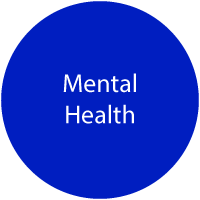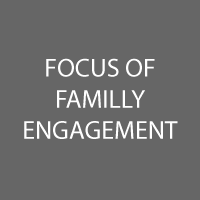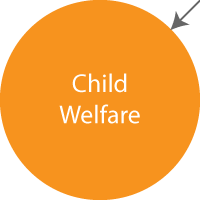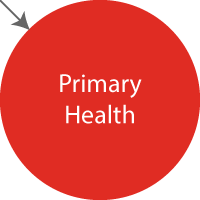Youth who receive special education services under the Individuals with Disabilities Education Act (IDEA 2004) and especially young adults of transition age, should be involved in planning for life after high school as early as possible and no later than age 16. Transition services should stem from the individual youth’s needs and strengths, ensuring that planning takes into account his or her interests, preferences, and desires for the future.
Service Level: Engaging Families as Partners in Decision-Making
Description of Family Engagement at the Service Level
Family engagement is essential in promoting positive child and youth outcomes in education, mental health, health, child welfare, and juvenile justice. These key child and youth serving systems are incorporating practices, policies and processes within their agencies to strengthen and implement meaningful family engagement at the service level. Increasingly, staffs are collaborating with family members in planning and decision-making regarding their children’s and youth’s needs, services, plans, and goals. Child and youth serving agencies are creating distinct family engagement approaches that align with their agency’s mission, goals, and performance and outcome measures. Each child serving system has focused their family engagement efforts on important service areas as reflected in the following diagram:
Family Engagement Focuses on Key Service Areas
 |
||||
 |
||||
 |
 |
 |
 |
 |
 |
 |
|||
 |
 |
Education — Meaningful family engagement in schools means that families and educators work in partnership to support all students in academics, social emotional learning and development and ultimately educational success, using research-based practices and supports in schools, classrooms, and at home.1
Child Welfare — Caseworkers engage families in individualized planning and goal setting related to safety, permanency and well-being for every young person and family receiving child protective services.2 Each family is to be respected and recognized as having expertise about their own family and need to be actively involved in making decisions for the young person.3
Juvenile Justice — Parents and families are actively engaged in the rehabilitation of juvenile justice-involved youth by serving in key roles as recipients, direct supports, extenders, or managers of services.4 Justice system providers are highly motivated and actively work to routinely integrate parent and family engagement within their system.
Mental Health — A family-driven care approach guides youth mental health providers including child psychiatrists, on how to effectively engage families in their child’s care.5 Family-driven care means family members have a primary role in decision-making and co-designing their child’s comprehensive service plan and treatment goals, including the selection of culturally and linguistically competent supports.6
Primary Health — Patient- and family-centered care is an approach to the planning, delivery, and evaluation of health care that calls for collaboration and partnerships among health care providers, patients, and families. In patient- and family-centered care, patients and families define their “family” and determine how they will participate in care and decision-making.7
Commonalities in Family Engagement Principles and Practices Across Service Systems
Child and youth service systems share commonalities in their family engagement principles and practices such as shared decision-making, collaboration, partnership, two-way communication, meaningful roles, mutual respect and acknowledgement of family expertise.8 These systems have articulated guiding principles that reflect the organization’s beliefs about why and how they will bring about family engagement.
Guiding principles are most effective when staff and families are involved in developing and regularly revisiting the philosophy that will guide how they operate. Meaningful family engagement also means that families can serve in various roles that contribute to their child’s progress and success in achieving personal goals.
Roles performed by families may include serving as a:
- collaborator in service planning,
- encourager,
- overseer of services,
- monitor,
- participant in services,
- parent peer support provider,
- advocate,
- decision-maker,
- cultural broker,
- learner, and
- trainer of families and staff to name a few of many roles that families can perform in support of their children.
Address Staff Readiness for Family Engagement
Although the impact and benefits are clear, implementing family engagement is not clear-cut. Family and staff partnership is most successful when both staff and families are prepared to communicate and collaborate. A lack of communication with and support for families is associated with lower levels of family engagement.9 Professional development on family engagement can help prepare staff and families on how to partner and collaborate. However, each staff and family must work at building trusting relationships as a foundation to engage in difficult conversations about needed change.
Some agencies encourage self-assessments to gauge agency and staff attitudes, beliefs, and readiness to work with families as equal partners. Some agencies also include family engagement metrics or indicators in staff/administrator evaluation and performance systems.10 Family engagement becomes an essential component of any collective impact strategy as human service sectors work to create a culture of shared responsibility for improving outcomes for all youth. Engaging families in our communities requires a shared effort with leadership, educators, providers and community members committing to engage families in purposeful ways to help them support their children’s development.11
Resources
Education (K-12)
The Family Engagement for High School Success Toolkit: Planning and Implementing an Initiative to Support the Pathway to Graduation for At-Risk Students
This toolkit features the work of 15 pilot sites across the country that developed a comprehensive family–school–community engagement initiative to support at-risk youth on the path to graduation. The toolkit offers structured, data-driven planning and implementation guidance on how to build family engagement and to strengthen school–family connections and partnerships.
Creating Conditions for Meaningful Family Engagement from Pre-K to High School
This guide is for educators and family leaders interested in strengthening family engagement in schools and classrooms. The guide highlights Substance Abuse and Mental Health Services Administration’s, Safe Schools/Healthy Students (SS/HS) Grantees and describes how they have advanced family engagement in their states and schools.
This webpage from the Centers for Disease Control and Prevention provides information and resources on parent engagement in schools
I Have a Question… What Parents and Caregivers Can Ask and Do to Help Children Thrive at School: A Parent Checklist
This tool provides a set of questions families can ask, and important issues to consider when approaching your child’s teachers, principals and counselors about your child’s progress and how to support your child’s learning.
Mental Health
Family-Driven Care: Are We There Yet?
This resource addresses the needs of both school and mental health systems, such as mutual understanding of approach, language, theories, and perspectives. It discusses how positive behavior supports, wraparound, and response to intervention are evidence-based frameworks that have served to unify the efforts of education staff, mental health practitioners, and families to improve youth outcomes. Includes an overview of evidence-based programs that include a family component.
Family-Driven Care in America: More Than a Good Idea
This resource recounts how the definition and principles of Family-Driven Care have impacted the fields of mental health and child psychiatry. Guided by family-driven principles, youth-serving systems are implementing policies and practices that engage families as active participants in treatment and in policy development and system reform efforts. Research shows that better outcomes are achieved when family members and youth have meaningful roles in their treatment as reflected by featured programs.
Child Welfare
Family Engagement Web-Based Practice Toolkit: Core Principles of Family Engagement Practices
This online toolkit includes an Organizational Self Study on Family Engagement assessment along with guidance, tools and resources for the field on how to improve family engagement practices across child welfare programs.
Child Welfare Information Gateway
This website presents child welfare practice models to emphasize family engagement as a cornerstone of achieving positive outcomes. These practice models build from a clearly defined vision and set of core values and contain definitions, explanations, and expectations of how an agency will operate and partner with families.
Primary Health
A Roadmap for Patient + Family Engagement in Healthcare
Patient and family engagement is considered essential in improving health care, health outcomes and overall population health. The roadmap highlights opportunities to improve our healthcare system by creating meaningful partnerships with patients and families; and is intended to spark ideas and action from individuals and organizations interested in advancing the work of patient and family engagement.
Profiles of Change
Profiles in Change is a section of the Patient and Family-centered Care website that features hospitals, clinics, and health systems that are advancing the practice of patient- and family-centered care in systems that specialize in children’s healthcare.
Engaging Patients and Families in Their Health Care
This resource contains tools and resources for providers and patients and family members on how to improve their healthcare experience and engagement such as tips for patients, questions to ask of their physicians and how to prepare for medical appointments.
Juvenile Justice
Family Engagement in Juvenile Justice
This comprehensive literature review addresses the role of family engagement for youths involved in the juvenile justice system; cites research documenting how jurisdictions have attempted enhanced engagement, including policies that encourage family engagement. The review further addresses resources that help families to understand the juvenile justice process including practices such as parent training, family therapy, and family visitation; and outcome evidence for programs with family engagement strategies as key components.
Engage, Involve, Empower: Family Engagement in the Juvenile Drug Treatment Courts
This brief provides recommendations for successful engagement of families in the juvenile drug treatment court process informed by key findings of a national survey, which measured court practices and staff perceptions related to family engagement. Also presented is essential information on substance use and addiction among young people; a self-evaluation tool to assess a court’s current practices; and features two juvenile drug treatment courts that demonstrate a strong commitment to family engagement.
Juvenile Defense Attorneys and Family Engagement: Same Team, Different Roles
This brief is intended for both juvenile defenders and the families of their young clients. It provides an explanation of the roles family members and defenders play in a young person’s case; emphasizes the importance of both sides understanding the other’s role; maps out the benefits of collaboration between defense attorneys and young clients’ families; and outlines the opportunities for family and attorney collaboration throughout the duration of a youth’s delinquency case.
References
1 U.S. Departments of Health and Human Services and Education, 2016
2 Child Welfare Information Gateway, 2016
3 Family Engagement Web-Based Practice Toolkit: Core Principles of Family Engagement Practices
4 Burke, Mulvey, Schubert, & Garbin, 2014
5 American Academy of Child and Adolescent Psychiatry, 2009
6 National Federation of Families for Children’s Mental Health, 2008
7 Institute for Patient and Family Centered Care
8 Child Welfare Information Gateway, 2017
9 Hoover-Dempsey, Walker, Sandler, Whetsel, Green, Wilkins, & Closson, 2005
10 Wood, Shankland, Jordan, & Pollard, 2014
11 Westmoreland, Lopez, & Rosenberg, 2009
Other Resources on this Topic
Announcements
Briefs
Collaboration Profiles
Data Sources
Feature Articles
Programs
Resources
Youth Topics
Youth Briefs
Research links early leadership with increased self-efficacy and suggests that leadership can help youth to develop decision making and interpersonal skills that support successes in the workforce and adulthood. In addition, young leaders tend to be more involved in their communities, and have lower dropout rates than their peers. Youth leaders also show considerable benefits for their communities, providing valuable insight into the needs and interests of young people
Statistics reflecting the number of youth suffering from mental health, substance abuse, and co-occurring disorders highlight the necessity for schools, families, support staff, and communities to work together to develop targeted, coordinated, and comprehensive transition plans for young people with a history of mental health needs and/or substance abuse.
Nearly 30,000 youth aged out of foster care in Fiscal Year 2009, which represents nine percent of the young people involved in the foster care system that year. This transition can be challenging for youth, especially youth who have grown up in the child welfare system.
Research has demonstrated that as many as one in five children/youth have a diagnosable mental health disorder. Read about how coordination between public service agencies can improve treatment for these youth.
Civic engagement has the potential to empower young adults, increase their self-determination, and give them the skills and self-confidence they need to enter the workforce. Read about one youth’s experience in AmeriCorps National Civilian Community Corps (NCCC).






